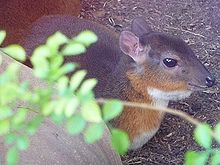| Royal antelope | |
|---|---|

| |
| Individual at the San Diego Zoo | |
| Scientific classification | |
| Domain: | Eukaryota |
| Kingdom: | Animalia |
| Phylum: | Chordata |
| Class: | Mammalia |
| Order: | Artiodactyla |
| Family: | Bovidae |
| Subfamily: | Antilopinae |
| Genus: | Neotragus |
| Species: | N. pygmaeus
|
| Binomial name | |
| Neotragus pygmaeus | |
| Synonyms[2] | |
|
Capra pygmaea Linnaeus, 1758 | |
The royal antelope (Neotragus pygmaeus) is a West African antelope recognized as the world's smallest. It was first described by Swedish zoologist Carl Linnaeus in 1758. It stands up to merely 25 cm (10 in) at the shoulder and weighs 2.5–3 kg (5.5–6.6 lb). A characteristic feature is the long and slender legs, with the hindlegs twice as long as the forelegs. Horns are possessed only by males; the short, smooth, spiky horns measure 2.5–3 cm (0.98–1.18 in) and bend backward. The soft coat is reddish to golden brown, in sharp contrast with the white ventral parts. In comparison to Bates's pygmy antelope, the royal antelope has a longer muzzle, broader lips, a smaller mouth and smaller cheek muscles.
Typically nocturnal (active at night), the royal antelope exhibits remarkable alertness. Territories are marked with dung. An herbivore, the royal antelope prefers small quantities of fresh foliage and shoots; fruits and fungi may be taken occasionally. Like other neotragines, the royal antelope is monogamous. Both sexes can become sexually mature by as early as six months. Births have been reported in November and December. A single, delicate young is born after an unknown gestational period.
The royal antelope prefers areas with fresh and dense growth of shrubs and other plants. It inhabits the warm, moist lowland forests prevalent in western African countries such as Côte d'Ivoire, Ghana, Guinea, Liberia and Sierra Leone. The royal antelope has been categorized as Least Concern by the International Union for the Conservation of Nature and Natural Resources (IUCN). The populations are feared to be declining due to habitat deterioration and expanding human settlement. A significant threat to the survival of this antelope is hunting for bushmeat.
- ^ IUCN SSC Antelope Specialist Group (2016). "Neotragus pygmaeus". IUCN Red List of Threatened Species. 2016: e.T14602A50190835. doi:10.2305/IUCN.UK.2016-1.RLTS.T14602A50190835.en. Retrieved 19 November 2021.
- ^ Groves, C.; Grubb, P. (2011). Ungulate Taxonomy. Baltimore, Maryland (USA): Johns Hopkins University Press. pp. 144, 147. ISBN 978-1-4214-0093-8.
